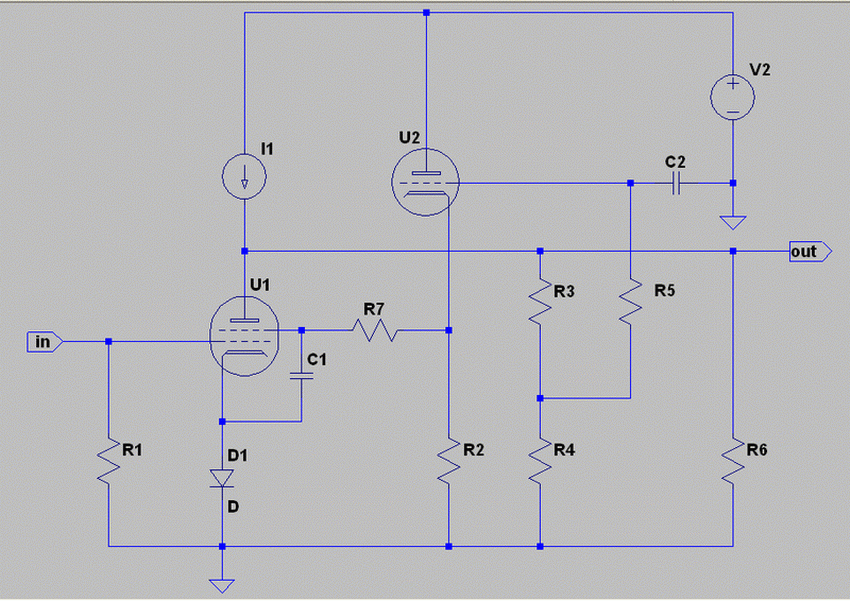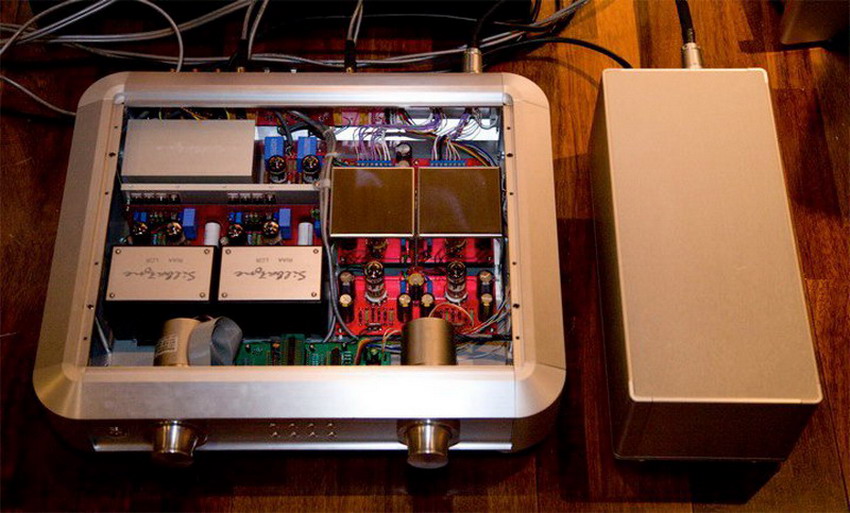 okay, its been a while since i’ve done anything here… its demolition by neglect. i have to work on this blog, or else! i don’t know what else… i’m an arrogant doormat. it’s all or nothing – two smoking barrels or a wet fuse. let me just write about something of the many many things i’ve worked on since i started this site.
okay, its been a while since i’ve done anything here… its demolition by neglect. i have to work on this blog, or else! i don’t know what else… i’m an arrogant doormat. it’s all or nothing – two smoking barrels or a wet fuse. let me just write about something of the many many things i’ve worked on since i started this site.
in the previous post about the 211 pp amps, i introduced a circuit i called a Gm amp. it turns out that there are many interesting and useful aspects to this circuit so its worth going into it in greater/better detail. it has immense gain and wide bandwidth at the same time. it’s also very low distortion. of course it is also crazy high impedance and often needs to be buffered. it has sounded wonderful too. every single arrangement i’ve tried! i can’t say that for much. however, after having made a whole bunch of them now, there is something obvious about the contraption… why does one need a gain of 40 – 60 + dB in one stage? yeah, its a great question. well, there are two easy answers, and one trickier one: phono and mic preamps (especially for ribbon mics), easy; any circuit requiring lots of error correction (feedback) or control design (sound effects and synthesis). but beyond these, and they should be explained, why so much gain?
i was reading a blog post on (gasp) diyaudio, involving an argument between john curl and bob cordell, scott wurcer, and in absentia matti otala and others. nelson pass was missing, but should have been there too, i suppose. it was borderline nasty. ahh, it was vicious. between heavy company too, i should say. it’s an old argument, 30 something years old, and i need to be up front that i stand in curl’s camp, although it begs to admit i can’t defend it with math or other explanation. i wouldn’t get so combative about it either… especially with those guys! cordell is a master measurer and an engineer of rare depth, and a genuinely decent man. at least from what i can tell. but, and i mean this simply, i’m not into his stuff. it sounds like hifi to me, and that isn’t a compliment. really good hifi, let me make that clear! among the best, let’s say… it undoubtedly is the best testing, most near to the engineering standard of performing excellence that is possible today. his work is backed up with science, measurement and a consistently thoughtful step by step approach. curl’s is much less so and he isn’t as eloquent in explaining his perspective. i still agree almost entirely with uncle john. it’s an empirical observation, but one that i have experienced many many times. but, i expect, like john, that at some point there will be a way to quantify and measure what i hear… even if it hasn’t happened yet. the argument goes like this:
it is tradition now to engineer amplifiers with a huge gain combined with feedback error correction so as to reduce all known forms of distortion to vanishing degrees. that is quite an accomplishment and a thing to say. it is also “true” in both the theoretical and current empirical methods of knowing this. a perfect example of this thinking, in a practical manner, is the now venerable AD747 op amp, which has a open loop bandwidth of 200Hz, and a gain of 20 million, roughly. designed by scott wurcer, who i recently made a fool of myself with! very nice guy. it is actually difficult to measure the distortion of that chip, at any of the ordinary gains one would use it closed loop. i have never owned gear of the quality needed to see it, much less measure. i use it, for test jigs and to check my circuits! it’s not even the best chip out there. however, and here’s the rub, that fact has NOT made musical reproduction using this approach, indistinguishable from actual music. in fact, and there are many of us who can attest to this, it is often the case that “non traditional” amplifiers, sometimes with comparatively high amounts of harmonic distortion (a euphemism for tube amps, but also to curl, charles hanson and others…) “sound” as good and sometimes much better and more real than the tradition can account for.
letting go of the controversy of this statement for the tradition, there are enough people in the “other” camp, ridiculed as they may be, to justify the necessity to keep the question open. why? well, curl and later hanson, based on work and ideas that began in the 70’s (Ottala), think that feedback in combination with the gain/voltage variable input and output impedance of amplifying devices plus the interactions with the load (speaker and cables), can create dynamic inter-modulated distortions (like frequency modulation/FM and phase modulation/PM) that are nasty in small amounts and are utterly electronic (having no correlation to the material world). one way to reduce the likelihood of these distortions (TIM, PIM) being created is to make amplifiers that have both a high gain AND a wide bandwidth, if you are using feedback. or, as a second option, no feedback at all. this is disputed bitterly between the “two” factions (its actually much more split and complex socially and politically).
you are walking down the street. around the corner to the left and down another street, there is someone playing piano inside a second story apartment. there’s an open window. you hear reflected, indirect, filtered sound and yet you immediately know it is a real person playing a real piano. let’s say it was a concert pianist practicing at home, playing something you know perfectly and even own recordings of… you still know it isn’t a recording played back electronically. there is no way any gear made today can fool you. at that distance and with all the obstacles between you and the source, you know, and many other people would know… not just the golden ears, it was real and not recorded. and vice versa.
for me, when the import of matti ottala’s work sunk in, and it was dick sequerra who indoctrinated me (when i worked for him), it appeared that he was pointing to a most implacable culprit for “electronic” sound. feldtkeller und zwicker, those most anal and german of scientists, said levels as low as -80dB were detectable in their research (this was for FM and PM; you will have to allow me to paraphrase here as i cannot do justice to such a huge body of work in casual terms… you go look it up when you have time). paul klipsch talked about this stuff with speakers (domes and cones). in any case, the time domain became more important at that moment, although not so much for mainstream audio engineering. let me make this clear: all amplifying devices have time dependent energy storage qualities… tube, transistor, and FET. the miller C (plate to grid) is one obvious culprit, and feedback in general, both local and global, are part of the problem. but no feedback is necessary to produce dynamically inter-modulated artifacts in a circuit. you also don’t need an active device to make TIM, PIM, FM or PM. transformers and caps in particular combination’s can do it too. tubes have less gain and less C, so they generally suffer less in simple applications than BJTs and FETs, leading some to believe this is one of the reasons for the perceived superiority of vacuum tubes. this is NOT so simple, and it has been my experience that they are more alike than any would be comfortable to admit. this is after years of playing with tubes, too.
and, there were/are other culprits… for example, most playback occurs over dynamic speakers! for all the issues of amplifiers, speakers are 100 times worse. and a speaker with a passive crossover is just plain horrible. the mass of the cone creates time problems alone, hysteresis, overshoot, oscillation… dome tweeters may even be one of the few physical devices that can create significant PM mechanically! forgetting the electrical problems, most cone speakers have a dynamic range 1/50th (or much less than that) that of real, and most repro is really compressed (distorted). let me not drift too far off topic… so easy for me to do. if it didn’t before, it should now make sense that so much effort goes into reducing distortion and preserving the time domain in electronic reproduction, as it would seem the only way to minimize the “electronic character” of it. and also, that the circuit should do as little wrong from the outset, before it is corrected and compensated. it has been my experience that circuits using active error correction (nfb) always sound better when none was needed in the beginning. okay, but the idea that it is still possible to fix “all” distortions with heaps of active error correction… i’m not convinced. and i suspect a price is paid for going at it so whole hog. it would seem that science is on the side of brute force control engineering. but the ears are not. at least not mine. i have recently heard the halcro stuff, for example, and i was laughing, at least inside. for me, it is so utterly electronic. it is just more of the same. one definition of madness, you hear out there, is doing the same thing over and over again expecting different results. if you want different results, you have to do things differently.
so why tubes and why a Gm amp? my answer is still the same after almost 30 years, even if tempered a bit by experience and decrepitude: simplicity. electrical simplicity. how to get it is usually more complicated than you think! but, it is possible to make circuits that are forgiving in overload, have the fewest possible number of parts, very little error correction, and sound the most like “real”. not perfect, but better than halcro, in my obviously biased opinion. and, the Gm amp allows both for the use of lots of feedback, or none at all. as a building block it seems to have more to offer than is possible with simpler triode circuits for certain applications and yet can straddle both the traditional and non-traditional approaches. it gives a great deal of flexibility to use tubes and yet approach or exceed the open and closed loop performance possible with solid state. let’s see what’s under the hood: schematic 1
here is your basic Gm amp stage. you see: U1, a pentode grounded cathode arrangement, with a diode used to set a fixed bias, a constant current source as a load, R3 and R4 set the screen voltage and provide DC feedback for stability, R5 and C2 decouple the signal from the screen, U2, a triode buffer for the screen, and R6 which, together with R3 and R4, provide the shunt resistance for the current difference between U1 and I1.
here is a practical implementation: schematic 2 this stage has a gain of 74 dB, THD 0.63%, and a bandwidth of roughly -3dB @180 Khz… this means that for 1 mV in, you get 10 V out. not too shabby! this is basically the first stage of the silbatone C-100, with some small changes in the supply and shunt system to get less gain and more bandwidth. here is an X/Y shot of the plate of the D3a in the C-100… 10 mV scale against the 5 V scale!
when i was at the most recent european triode festival (ETF), i met frank blöhbaum, the inventer of the “super pentode” circuit, it became apparent that he is also using “Gm amps”, so i am not alone! i wasn’t sure about that anyway, and i am always nervous about claiming anything tube for my own…. some old US navy guy probably did it already and never got credit for it! we all stand on someone else’s shoulders: i’m trying to be honest about that. anyway, he is a nice guy, and really fucking clever too. but, i have never seen anyone else use a Gm amp in any commercially produced piece of equipment except for me and frank. we have different styles, too… i picked up a simple inexpensive mod from frank, that you should know about: using an MPS44 as the screen buffer. then you can use the other half of your dual pentode/triode for a buffer or something else. i do not consider it cheating to go hybrid. i’m an authentic original organic synthetic hybrid myself, and am in no way associated with “purism” of any kind, which is a form of insanity for me. it cracks me up, though, that hybrid design, that which mixes solid state with vacuum tubes for analog circuits, gets the reaction it sometimes does from certain quarters… it’s like the reaction straight and gay people give to bisexual behavior: it makes em nervous. reminds them that we are all bi! here’s a pic of the guts of the Silbatone C-100.
i’ll post more images later.


